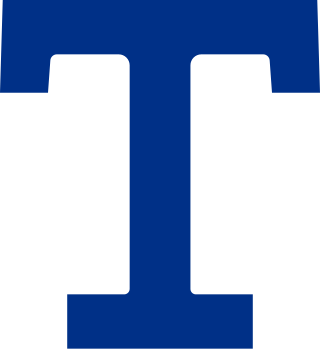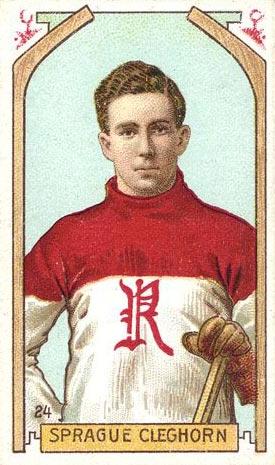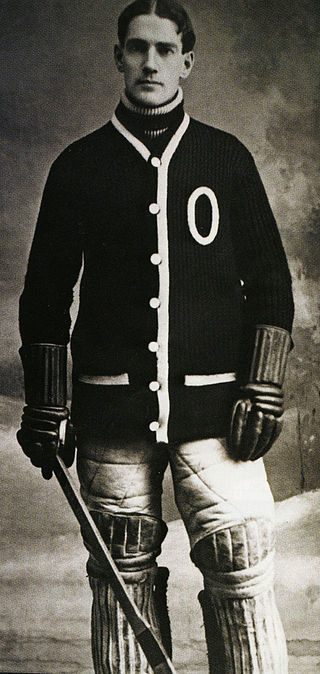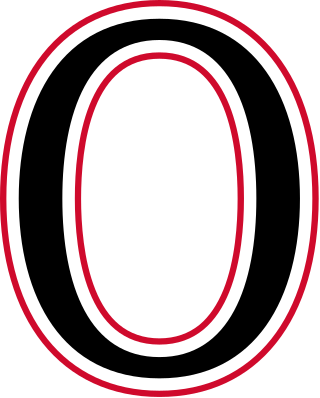
The Quebec Bulldogs were a men's senior-level ice hockey team based in Quebec City. The team was officially known as the Quebec Hockey Club, and later as the Quebec Athletic Club. One of the first organized ice hockey clubs, the club debuted in 1878 with the opening of the Quebec Skating Rink. The club continued as an amateur team through various leagues, eventually becoming professional in 1908. The club would play in the National Hockey Association and the National Hockey League. In 1920, the team moved to Hamilton, Ontario and became the Hamilton Tigers.
The National Hockey Association (NHA), initially the National Hockey Association of Canada Limited, was a professional ice hockey organization with teams in Ontario and Quebec, Canada. It is the direct predecessor of today's National Hockey League (NHL), and much of the business processes of the NHL today are based on the NHA. Founded in 1909 by Ambrose O'Brien, the NHA introduced 'six-man hockey' by removing the 'rover' position in 1911. During its lifetime, the league coped with competition for players with the rival Pacific Coast Hockey Association (PCHA), the enlistment of players for World War I and disagreements between owners. The disagreements between owners came to a head in 1917, when the NHA suspended operations in order to get rid of an unwanted owner, Eddie Livingstone.
The 1917–18 NHL season was the first season of the National Hockey League (NHL) professional ice hockey league. The league was formed after the suspension of the National Hockey Association (NHA). Play was held in two halves, December 19 to February 4, and February 6 to March 6. The Canadiens won the first half, and Toronto the second half. The season was contested by four teams, down from six in the previous season, finishing with only three, in Montreal, Ottawa and Toronto. The Montreal Wanderers withdrew early in January 1918 after their rink, the Westmount Arena, burned down. Toronto won the NHL playoff and then won the Stanley Cup, by defeating the PCHA's Vancouver Millionaires three games to two in a best-of-five series.

Maurice Joseph Malone was a Canadian professional ice hockey centre. He played in the National Hockey Association (NHA) and National Hockey League (NHL) for the Quebec Bulldogs, Montreal Canadiens, and Hamilton Tigers from 1910 to 1924. Known for his scoring feats and clean play, Malone led the NHL in goals and points in 1918 and 1920, and the NHA in goals twice, in 1913 and 1917. He won the Stanley Cup with Quebec in 1912 and 1913. He is the only player in the history of the NHL to score seven goals in a single game, accomplishing the feat in 1920. He was elected to the Hockey Hall of Fame in 1950.

The Toronto Hockey Club, known as the Torontos and the Toronto Blueshirts, was a professional ice hockey team based in Toronto. They were a member of the National Hockey Association (NHA). The club was founded in 1911 and began operations in 1912. The club won its sole Stanley Cup championship in 1914.
The 1919–20 NHL season was the third season of the National Hockey League (NHL). A Quebec team was activated by the NHL, increasing the number of teams to four. The four teams played 24 games in a split-schedule format. The Ottawa Senators won the league championship by winning both halves of the split-season. The Senators went on to win the Stanley Cup for the first time since the Cup challenge era ended and their eighth time overall, by defeating the PCHA's Seattle Metropolitans three games to two in a best-of-five series in the Stanley Cup Finals.

Henry William Sprague "Peg" Cleghorn, also known as "The Big Train", was a Canadian professional ice hockey player from Westmount, Quebec who played 17 professional seasons between 1911 and 1929 for the Renfrew Creamery Kings and Montreal Wanderers in the National Hockey Association (NHA) and the Ottawa Senators, Montreal Canadiens and Boston Bruins in the National Hockey League (NHL). He was a member of three Stanley Cup championship teams, winning with the Senators in 1920 and 1921 as well as with the Canadiens in 1924. His brother Odie was also a professional player and the two played several seasons together.
The 1920–21 NHL season was the fourth season of the National Hockey League (NHL). Four teams each played 24 games in a split season. The Quebec franchise was transferred to Hamilton, Ontario, to become the Hamilton Tigers. The Ottawa Senators won the league championship in a playoff with the Toronto St. Patricks. The Senators went on to win the Stanley Cup by defeating the Vancouver Millionaires of the Pacific Coast Hockey Association three games to two in a best-of-five series. This would be the last split season before the NHL changed its regular season and playoff formats.
The 1925–26 NHL season was the ninth season of the National Hockey League (NHL). The NHL dropped the Hamilton, Ontario, team and added two new teams in the United States (US), the New York Americans and the Pittsburgh Pirates, to bring the total number of teams to seven. The Ottawa Senators were the regular-season champion, but lost in the NHL playoff final to the Montreal Maroons. The Maroons then defeated the defending Stanley Cup champion Victoria Cougars of the newly renamed Western Hockey League three games to one in a best-of-five series to win their first Stanley Cup.

Percivale St-Helier LeSueur, known as "Peerless Percy", was a Canadian senior and professional ice hockey goaltender and later involved in the game as referee, coach, manager and owner. He was a member of the Smiths Falls Seniors for three years, with whom his performance in a 1906 Stanley Cup challenge series attracted the attention of his opponents, the Ottawa Silver Seven. Although his team lost the series, LeSueur excelled in goal, keeping the games close. Nine days after the defeat, he joined the Silver Seven and played in a challenge match against the Montreal Wanderers. He remained with Ottawa through the 1913–14 season where he served as team captain for three seasons, and assumed coaching duties in his final season with the team.

The Ottawa Senators were an ice hockey team based in Ottawa, which existed from 1883 to 1954. The club was the first hockey club in Ontario, a founding member of the National Hockey League (NHL) and played in the NHL from 1917 until 1934. The club, which was officially the Ottawa Hockey Club, was known by several nicknames, including the Generals in the 1890s, the Silver Seven from 1903 to 1907 and the Senators dating from 1908.
The 1910–11 NHA season was the second season of the now defunct National Hockey Association. The Ottawa Hockey Club won the league championship. Ottawa took over the Stanley Cup from the Montreal Wanderers and defended it against teams from Galt, Ontario, and Port Arthur, Ontario.
In 1970, the Junior A level was divided into two more levels, Tier I and Tier II. In 1974, the "Major Junior A" division of the OHA became the Ontario Major Junior Hockey League (OMJHL) and began to operate independently of the OHA. Finally in 1980, the OMJHL became the Ontario Hockey League.

The 1917–18 Toronto Hockey Club season was the first season of the new Toronto franchise in the newly-organized National Hockey League (NHL). The team was intended as a 'temporary' franchise, operating without an official club nickname and without a formal organization separate from the Toronto Arena Company that managed the Arena Gardens. Despite this, the team came together to win the first NHL Championship, competing against existing teams that had transferred directly from the National Hockey Association (NHA). Toronto would go on to win the Stanley Cup by defeating the Pacific Coast Hockey Association champion Vancouver Millionaires – the first Stanley Cup for an NHL team and the second Cup for a Toronto team after the Toronto Blueshirts' victory in the 1913–14 season of the NHA. To this day, the Toronto Arenas are the only team in the four major North American sports to win the title in their first season as a franchise.

The National Hockey League (NHL) was founded in 1917 following the demise of its predecessor league, the National Hockey Association (NHA). In an effort to remove Eddie Livingstone as owner of the Toronto Blueshirts, a majority of the NHA franchises suspended the NHA and formed the new NHL. The Quebec Bulldogs, while a member, did not operate in the NHL for the first two years. Instead the owners of the Toronto Arena Gardens operated a new Toronto franchise. While the NHL was intended as a temporary measure, the continuing dispute with Livingstone led to the four NHA owners meeting and making the suspension of the NHA permanent one year later.
The 1917–18 Montreal Canadiens season was the team's ninth season and first as a member of the new National Hockey League (NHL). The Canadiens sided with other members of the National Hockey Association (NHA) and voted to suspend the NHA and start the NHL to expel the Toronto Blueshirts ownership. The Canadiens qualified for the playoffs by winning the first half of the season, but lost the playoff to the temporary Toronto franchise, made up of Blueshirts players.
The 1917–18 Montreal Wanderers season was the 15th and final season of play of the Montreal Wanderers ice hockey club. Along with the Canadiens, Ottawa and Quebec, the club voted to suspend the National Hockey Association (NHA) and form the National Hockey League (NHL) to freeze out the Toronto NHA franchise owner. On the ice club still had difficulties fielding a competitive club, and when the Montreal Arena burned down, owner Sam Lichtenhein elected to suspend the club. The team is officially credited with having played six games, though they only actually played the first four; the other two were declared forfeit.
The 1920–21 Hamilton Tigers season was the first season of play for the new Hamilton Tigers team in the National Hockey League (NHL). The Tigers finished in last place in both halves of the season and did not qualify for the playoffs. The team previously had played in Quebec City, where they were known as the Quebec Bulldogs, but had been sold to Hamilton interests in 1920. Joe Malone led the team in scoring, with 28 goals in 20 games.
The 1925–26 New York Americans season was the first season of the New York Americans ice hockey team of the National Hockey League. Despite having the roster of the previous season's top club, the Hamilton Tigers, the club finished in last place.









